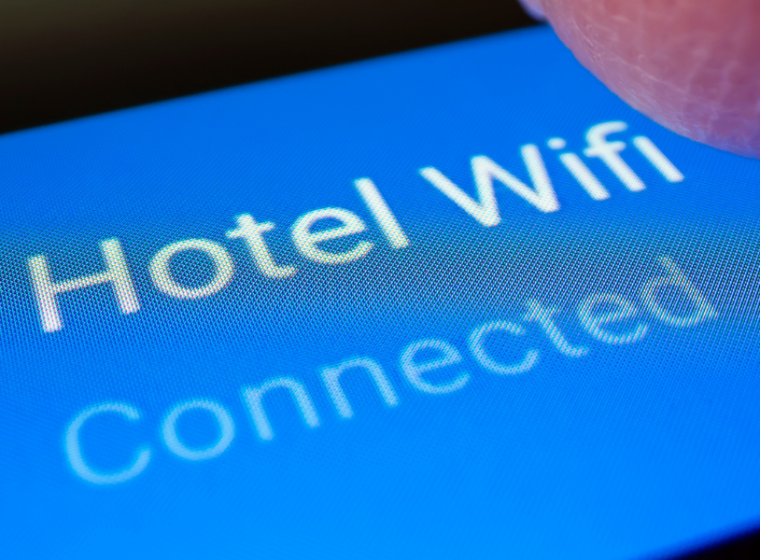How do Hotels Get WiFi in Every Room?
Deploying a hotel WiFi network is both an art and a science. It demands the right balance of tech selection and tech utilization, all in an effort to maximize connectivity, reliability, and security.
WiFi technology today is vastly different than it was just a few years ago. Higher capacity access points, multiple antennas, and faster routers have all advanced the performance of hotel wireless setups and guest room experiences.
Where the art comes into play is the placement of access points, overall network design, and the intuition to adapt a network’s configuration based on unexpected challenges. We’re going to dig into how hotels get WiFi in every room and seamlessly deliver high-end connectivity.
Hotel WiFi Infrastructure: What’s Involved?
‘One-size-fits-all’ or ‘copy-paste’ WiFi networks are no longer viable for today’s most highly-sought hotels. The talent invested in high-performing wireless networks involves a high level of mental throughoput and design consideration.
In simple terms, delivering dedicated guest room WiFi relies on the network’s infrastructure of routers, access points, and switches. Routers bring Internet connectivity into the hotel and carry the connection out to a group of access points, which are mindfully placed to optimize network performance.
Because more access points are utilized in larger facilities like hotels, more switches are often required to connect the access points. These devices are strategically positioned throughout the premises to provide guests and staff with high-quality Internet service. Depending on the hotel’s size, layout, and materials used, a dedicated access point per guest or guest room may be required.
In addition to WiFi design and infrastructure, hotels may deploy a property management system (PMS) that handles policy setup, login pages, bandwidth management, and various network usage metrics. These systems provide a more robust and integrated way to manage a hotel’s wireless network.
Hotel WiFi Network Setup Considerations
Today’s modern WiFi technology is both powerful and flexible, enabling managed providers to deliver top-notch Internet service. But tech alone is only one piece of the equation. WiFi designers consider many different factors when architecting hotel network setups.
Site Survey
Site surveys are a critical stage in the WiFi design phase. A site survey determines the size and infrastructure of a hotel’s WiFi design by identifying the optimal sites for maximizing range and reducing channel interference. Site surveys also test how WiFi signals travel through the building, which also influences tech selection and placement used.
Network Usage
Determining the types of applications used across the network can be helpful in the selection and placement of hardware. Voice and video apps are common across both guests and staff, and these high-demand uses require reliable connectivity. FaceTime, Zoom, Slack, Skype, and many social media platforms require coherent roaming so that users never drop connection.
WLAN Roaming
The distribution of throughput in a wireless local area network (WLAN) is generally determined by the proximity of access points. Overlapping access points is a technique leveraged to improve throughput and minimize drops or network inefficiencies. A hotel’s WiFi designer must consider users navigating from one access point to another while moving about the premises, and seamlessly transition that user’s connection without any interruption.
Construction Materials
What construction materials were used to build the hotel you’re designing the WiFi for? Different building materials can impact RF signal and Wifi connectivity. Is it drywall, cinder block, brick, reinforced concrete, or stud construction? In existing hotels or historic buildings, it’s not uncommon to come across metal construction materials, which can influence the performance and design of the overall wireless network.
Infrastructure Hardware
The array of devices used across a network’s infrastructure consists of the crucial components that support the connectivity needed for apps, data, multimedia, and guest service. This is separate from the devices that guests and staff use directly and focuses on the hardware that makes up the wireless network as a whole. This includes things like routers, servers, switches, access points, storage area networks, and intrusion detection systems.
Types of Client Devices
The devices that end-users carry with them during their stay are fairly predictable in hotels, usually ranging between various mobile devices, wearables, and laptops. In addition to the volume of network users, the demands required on behalf of guests (and staff) can influence network decision-making and how to effectively get WiFi in every room.
Managed Hotel WiFi to Meet Your Guests’ Needs
Some hospitality businesses have the capacity to manage their network in-house. These types of businesses – which typically fall on either end of the spectrum like a small bed and breakfast or a major hotel brand – can develop the capacity to adopt all setup, maintenance, and upkeeping/upgrading of the network.
For the remaining vast majority of hotels, working with a specialized managed network provider delivers the best line of support and ROI. Designing and managing a WiFi network can be a costly undertaking. It’s critical to establish a hotel WiFi infrastructure that supports the range, coverage, and overall activity in a secure and stable manner.
Learn more about hotel WiFi systems from Blueprint RF or get the ball rolling today by contacting us.









